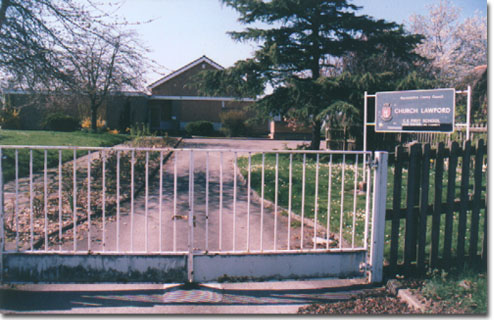On 6th February 1964 the newly built village school opened its doors to children for the first time.
The new school was also on School Street, just a hundred yards or so further down the street, opposite the Village Green, in an area formerly part of Fir Tree farm, and it was also next to the village reading room. It was a junior and infants school, originally operating with three classes and catering for ages 5 to 11. It quickly built up a good reputation, such that some children from Bretford, Wolston and Long Lawford also attended the school for their entire primary education (noting that the old school has also attracted pupils from surrounding villages). The Infants class (Class 3) taught children in their first three years of schooling. Class 2 was for the next two years, and then Class 1 was for two further years leading up to the “Eleven-Plus” exam. Children would then move into secondary education, either at one of the schools in Rugby, or Wolston High School.

The first school head was Miss Baker, who had been headmistress at the old school for 10 years up until then. As the school opened in the middle of a school year the group of children doing their eleven-plus that year continued in the old school. By the start of the Easter Term in 1964 there were 77 on the school roll. Miss Baker had to deal with multiple teething issues with the new building, notably with the oil-powered heating, and also a number of break-ins, particularly in the school holidays. Those helping from the village were Mrs Ingram – the school cook, Mrs Heckford (snr) the school helper, Mrs Farmer (snr) the Caretaker (Mrs Cresswell joined her shortly afterwards) and Mrs McCrow the dinner assistant. Mrs Hagan began as the “traffic warden” shortly afterwards, helping the children across the main road in the days before the reduced speed limit. Events at the school would include the visits each term of the school nurse, football and netball matches and athletic events against nearby schools, weekly swimming classes at Rugby baths in Regent Street, school trips such as the visit to Dudley Zoo in the early years, or visits from various guests on topics such as road safety (Coco the clown). Music competitions, school choir events and rural sports days were held in conjunction with other local schools, as well as them staging the cycling proficiency test. Mrs Wotherspoon and Mrs Faizey were the school managers, both having had teaching experience (Mrs Wotherspoon had been headmistress at the old school in the past, and Mrs Faizey helped out with the teaching at the new school).
Miss Baker moved on to become head of Bawnmore Junior School in Rugby at Easter in 1966, and was followed by Mr Greves for the Summer Term that year. There were 80 on the school roll when Mr Greves took over. After three years he left and Mrs Martin took over for the next eleven years, with 63 children on the school roll when she took over.
In these days the school was also used for Parish Council meetings, as well as for voting in the local and general elections.
Shortly after the school was opened there was a dedication service for the Church of England school. This was reported in the March 1964 newsletter thus
On. Tuesday, February 18th about 90 Parents and friends attended the Dedication Service of our Church Lawford C. of E. Primary and Junior School.
The Rev. G.R. Fishley (Diocesan Director of Religious Education) dedicated the School, the Rector assisting at the Service.
David Wilkins, head of school read St Luke II verses 41-52 and Susan Smallman read Philippians IV v 4-8.
The hymns were Thy Hand, O God, has guided, Teach me my God and King” and “Praise my Soul the King of Heaven”.
Mr. E.J. Ruscoe, Divisional Education Officer, Mr. & Mrs. Morgan (Chairman of Parish Council) The School Managers and Miss Townsend attended. Miss Townsend, who was the first to be baptised (1873) in our present church, remarked on the good behaviour, excellent reading and singing of the children. Miss W. Baker, Head Teacher, and her staff are to be congratulated on having such a spacious and up to date School.
Keith Sinfield recalls in his 2014 article for the village newsletter that in 1964 the village had a post office & shop, the triangle garage, public house and a brand new school. The closure and subsequent demolition of the old school in the early 1970s gave birth to ‘The School Houses Charity’. This charity, established in 1980, disburses the income from a portion of the proceeds from the sale of land on which the old school once stood. Under the terms of the charity, those residing in our two parishes may apply for modest grants to further religious or general education.
